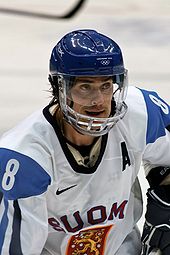Team captain (ice hockey)
| Team captain |
|---|
| Ice hockey positions |
|
Goalkeeper Defender Left Wing - Center - Right Wing |
| Others |
| Enforcer - Grinder - Team Captain - Pest - power forward - Rover |
The ice hockey team captain is the only player who is allowed under the rules of ice hockey to speak to the referee about his interpretation of the rules. It is marked with a "C" on the chest, in Russian-speaking countries also with a "К". The captain is seen by fans and the media as a representative of the team and the face of the team. He is the one who represents the entire team to the coach or management when it comes to the interests of the players. Ice hockey clubs may have up to two assistant captains who represent the regular captain in his absence. A captain is also a pillar for young players who are to be integrated into the team.

Selection process
Most of the time the team management or the coach chooses the captain, but in some teams the players choose their captain. Team captains are very often players with experience who have also been part of the team for a long time. Any player can be elected captain, with the exception of the goalkeeper. The selection is seen as a special moment as it can change the style of play and the image of the team.
The "C" is a special symbol and an honor for every player. However, there is a responsibility to be the leader of the team. The captain is the player who is authorized to speak to the referees if there is a dispute during a game. In addition, he is the link between the coach and the team. How important the office is can be seen in a few examples: In 2000, the 19-year-old Vincent Lecavalier was appointed captain by the team owner of the NHL team Tampa Bay Lightning . Lecavalier failed and the team owner's competence was called into question. Eric Lindros lost his captaincy in Philadelphia when he criticized the team's medical department.

Assistant captains
Teams can have up to two assistant captains. When the captain is not on the ice, an assistant captain in play may take over the role of the captain and speak to the referees. They also take on the role if the captain is injured, a penalty has just been pronounced against him or no captain has been named. The assistant captains wear an "A" on their chest. There are even teams competing without captain and instead up to four assistant captains have, as in the NHL during the 2007-08 season with the St. Louis Blues and Chicago Blackhawks or 2018/20 at the Detroit Red Wings of the case was. The Tampa Bay Lightning even went into the seasons without a captain for the first three years of their existence.
history
In the 1947/48 season , the National Hockey League ordered all teams to mark their team captains with a "C" and their assistants with an "A". After an injury to Toe Blake , goalkeeper Bill Durnan took over the captain's "C" for the Montréal Canadiens . He wasn't the first goalkeeper to take on the role of captain, but he was the only one to wear the "C" on his shirt.
However, the NHL and the International Ice Hockey Federation IIHF changed the rules in the summer of 1948, so that a goalkeeper could no longer be the captain. The reason for this was the delays in the game, as the goalkeeper sometimes had to walk to the other end of the ice to speak to the referee. In autumn 2008, Roberto Luongo of the Vancouver Canucks was appointed for the first time again a goalkeeper to captain an NHL team, but he is not allowed to wear the "C" or discuss with the referee and must be represented on the ice in the captain's role by field players.
The longest captain of a team in NHL history is Steve Yzerman , who wore the Detroit Red Wings "C" from 1986-2006. He is followed by Ray Bourque , captain of the Boston Bruins from 1985 to 2000, Mario Lemieux , captain of the Pittsburgh Penguins 1987-1994, 1995-1997 and 2001-2005, and Joe Sakic , captain of the Quebec Nordiques / Colorado Avalanche - franchises from 1990 to 1991 and 1992 to 2009.
particularities
Several teams have already changed their team captain on a monthly basis, such as the Buffalo Sabers in the 2003/04 and 2007/08 seasons and the Minnesota Wild between 2000 and 2009.
A similar system followed the San Jose Sharks in the first half of the 2003/04 season after the departure of long-time captain Owen Nolan . There the "C" changed every ten games before they decided on Patrick Marleau .
With the Buffalo Sabers from 2005 to 2007 Chris Drury and Daniel Brière alternated as captain. The one of the two who did not wear the "C" in a game acted as assistant captain.
In 2016, Connor McDavid was named the youngest team captain in NHL history by the Edmonton Oilers at the age of 19 years and 266 days. When he was appointed, he was exactly 20 days younger than Gabriel Landeskog of the Colorado Avalanche, who set this record on September 4, 2012. Brian Bellows was even younger when he took over as team captain after Craig Hartsburg's injury in January 1984 and filled it through to the end of the season. However, Bellows is only listed as an interim captain in the record lists.
